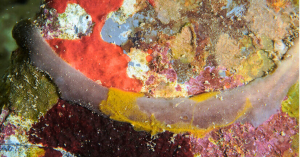UH researchers discover 10 new sponge species in Kāneʻohe Bay
University of Hawaiʻi at MānoaHawaiʻi Institute of Marine Biology
Moanikeʻala Nabarro , (808) 600-4084
Spokeswoman, UH Communications
In a series of newly published groundbreaking studies, researchers at the University of Hawaiʻi at Mānoa Hawaiʻi Institute for Marine Biology (HIMB) identified 10 new species of marine sponges found in Kāneʻohe Bay, shedding light on an often-overlooked but vital part of coral reef ecosystems.
Published in the journals PeerJ and Zootaxa, these findings were discovered using an innovative technique that explores both genes and structural characteristics. Despite their status as one of Earth’s oldest lifeforms, marine sponges remain vastly understudied. These newly identified species contribute to a broadening understanding of sponge biodiversity within the Hawaiian archipelago and throughout Oceania.
The HIMB research team, working out of the Toonen-Bowen “ToBo” Lab, used autonomous reef monitoring structures (ARMS)—specialized devices that mimic the reef’s natural environment—to collect sponge specimens without disturbing the fragile ecosystem.
“We used ARMS to collect sponges from within the reef,” said Rachel Nunley, a Scientists in Parks (SIP) intern at Kaloko-Honokōhau National Historical Park and lead author of the PeerJ study that identified six new species. “After sponge collection, we used DNA analysis to narrow down what species we were looking at. We found that these species in Kāneʻohe Bay were new to science and have not been documented anywhere else in the world.”
Kāneʻohe Bay, where HIMB is located, is abundant with small, isolated “patch reefs,” which are teeming with undescribed sponge species as well as non-native species introduced from the Caribbean and the Western Indo-Pacific.
Challenges of studying sponges
Unlike other marine life, sponges present unique research challenges due to their small size, fragility and dynamic nature.
“Sponges are found within the ‘nooks and crannies’ of the reef, making them difficult to collect without destroying the reef,” said Jan Vicente, a postdoctoral researcher at ToBo Lab and lead author of the Zootaxa study that identified four additional sponge species.
“Sponges are widely underappreciated, even though they play an essential role in cycling nutrients that help maintain coral reef biodiversity in remote island archipelagos where nutrients in coral reefs are scarce,” said Vicente.
Merging science with ʻike Hawaiʻi (ancestral knowledge)
To honor the cultural significance of their discovery, researchers named the new species based on traditional moʻolelo (stories) or ʻōlelo Hawaiʻi (Hawaiian language) that reflect the species’ characteristics.
“They were found in Kāneʻohe Bay off the island of Moku o Loʻe, and their names come from Native Hawaiian stories,” explained Robert Toonen, principal investigator of the ToBo lab and co-author on both studies. “‘Lo‘e,’ for example, was the sister of three brothers who kept honesty within the family.”
Future of reef research
The research team has sampled more than 1,000 specimens from the coral reef cryptic fauna using ARMS in Kāneʻohe Bay, and they have also recovered ARMS from five different ecoregions across the Pacific. In time, they hope to understand the complete diversity of Oceania. HIMB researchers want to determine which species are endemic, native, and which have been introduced to the Hawaiian archipelago, and how the species are connected.
Funding for this research was provided by the National Science Foundation (NSF) and the National Oceanic and Atmospheric Administration (NOAA Ocean Acidification Program.

